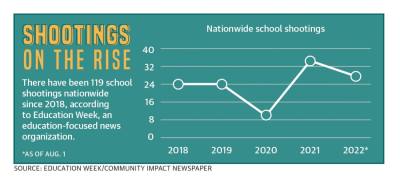In the wake of the May 24 shooting at Robb Elementary School in Uvalde, which left 19 students and two teachers dead, officials said safety and security became a top priority.
Gov. Greg Abbott released a set of mandates to the Texas School Safety Center on June 1 for school districts to implement by September. These requirements included conducting a smaller-scale security audit over the summer, training all staff on security procedures and instituting random intruder audits from the Texas School Safety Center on all campuses.
Austin, Round Rock and Pflugerville ISDs have been updating security and safety measures this summer at all campuses campuses to identify loopholes where a security breach could occur. All three districts also have police chiefs who began their terms in July, leading their own police departments to undergo security drills ahead of the school year.
“I want to assure [parents] that we’re going to use every resource possible to ensure that their kids are safe on campus. If kids don’t feel safe, they can’t learn,” AISD Police Chief Wayne Sneed said.
To tighten security on campus, AISD has seven law enforcement officers who are solely assigned to the school patrol division, Sneed said. All PfISD staff wear identification badges and are going through drills, PfISD Chief Communications Officer Tamra Spence said.
Officials at all three districts said they are concerned about making sure students are able to continue learning without feeling the stress of security and police on campus. RRISD employed Navigate 360, a safety audit company, to perform safety audits before schools reopened in mid-August.
“We’ve actually kind of instituted an innovative model of policing [at Round Rock ISD] that’s actually been nationally recognized already where safety obviously is our top priority,” said Jenny LaCoste-Caputo, chief of public affairs and communications at RRISD.
Security measures in schools
Additional security measures include adding surveillance cameras, bulletproof glass, magnetic locks, vestibule doors, door-locking systems and more law enforcement officers.
LaCoste-Caputo said RRISD focuses on teacher training and extensive background checks, especially for security clearance when someone requests access to enter a school.
PfISD also uses secure front entry vestibules to require anyone entering a school to go into the front office, Spence said. AISD uses third-party monitoring for online threats to school security, Sneed said. These tools work hand in hand with tips from parents and staff.
“We are going to be much more vigilant and visible, and we also have talked to some other law enforcement partners that have agreed to help us out,” Sneed said at AISD’s School Safety Summit on Aug. 6 of the district’s patrol plans.
AISD has about $30 million available for security vestibules, AISD interim Superintendent Anthony Mays said. The vestibules, or entryways into the building with a double set of doors, were funded through the 2017 bond program. The district could have another $30 million in the proposed 2022 bond if approved by voters.
Previous grants and bond money
Prior to Uvalde, districts were updating school security through grants from Texas Senate Bill 11, which passed in 2019 after the May 2018 shooting at Santa Fe High School that left 10 dead.
The bill allotted $100 million to the Texas Education Agency to help school districts update security. Additionally, bonds passed in 2018 in each of the three area districts allocated funds to update security.
With bond money from RRISD’s $508.4 million 2018 bond, the district spent about $30 million of the bond to address safety issues, and most of these projects are complete, LaCoste-Caputo, said.
The district’s $287 million bond package from 2014 added security vestibules, but a number of schools built before 2000 did not have secure front entries, Spence said. The 2018 bond allocated $8.6 million for security cameras, intrusion detection and access controls, and campus fencing.
Mental health
Security is not the only focus of district officials. They also each have mental health plans in place.
Abbott enacted a school and firearm safety action plan that states early intervention of mental health issues can minimize delinquent and violent youth from a future of crime.
“It is not necessarily a crime to be in a mental crisis. And so we don’t want to victimize somebody or criminalize that behavior, but also provide understanding in those cases where it’s appropriate,” Sneed said.
At AISD, counselors are available for students and staff needing any kind of help.
“Counselors have peace corners, brain labs; they have places where students are being able to be regulated because we move through a trauma-informed lens with all of our students,” said Twyla Williams, director or counseling, crisis and mental health at AISD.
Moving forward, officials with local school districts said they are on alert when it comes to safety and security no matter how much they prepare for life on campus after Uvalde.
“Safety, security is everyone’s responsibility to our students,” Sneed said. “The more eyes and ears we have, the better [and] safer our campuses can be.”










